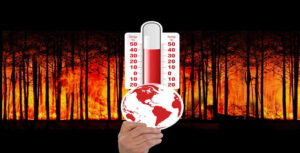This article is about Industries That Contribute to Global Warming/climate change. CO2 emissions can be linked to most of the activities and goods that we consume on a daily basis. However, there are some industries that are more carbon-intensive and end up contributing more to the climate change than others.
In this article we will present the 10 carbon-intensive industries that contribute the most to global warming.
1. Electricity & Heat
The primary source of greenhouse gases (GHG) emissions that contribute to climate change is electricity & heat production. This industry accounts for 31% of all GHG emissions worldwide. Although environmental policies and regulations are being implemented to switch this source to renewables or nuclear, this situation is still many decades away, especially in developing countries.
According to Our World in Data, the main source still used for energy production worldwide is fossil fuels burning (84.3%) like coal, gas or oil. During this process, large quantities of CO2 are emitted to the atmosphere.
Image 1: Energy consumption by source. Source: Our World in Data
2. Transport
Transport accounts for 16% of all GHG emissions. This includes air transport, road freights, passenger cars and shipping. Most of the GHG emissions in this industry (45%) come from passenger road vehicles (cars, motorcycles, buses and taxis). 29% of the emissions correspond to road freight transport like trucks and lorries, and the rest to aviation, shipping and rail.
3. Agriculture
Agriculture industry is essential for human lives, since without food we wouldn’t be able to survive in earth. However, modern agriculture practices are damaging not only our soils but also causing large amount of GHG to accumulate in the atmosphere contributing to global warming. Some of these modern practices include:
- Deforestation through forest fires (releases big amounts of CO2 during the fires and after, in addition to removing the main source of CO2 capture from earth)
- Use of nitrogen fertilizers (releases N2O, a GHG 298 times more potent than CO2)
- Use of toxic chemicals and pesticides (for example the use of glyphosate as a pesticide, that damages not only the soil and diversity but also puts in risk the surrounding communities)
The damage in the soil also causes big amounts of stored carbon to be released and thus depleting its carbon storage capacity. Methods and practices to restore this soil’s capacity can be found in projects like “kiss the ground”.
4. Livestock
Like agriculture modern practices, livestock farming in the 20th century has completely changed the way we used to relate with nature. These practices are not only very stressful for the animals, that are gathered in sheds, but also for the planet. The fact that so many animals are forced to stay in such small places causes them to get sick very often and to contract different types of diseases. This is why this industry makes year after year, large investments in antibiotics for these animals. Not only to prevent diseases but also to enhance their growth, with 80% of all world’s antibiotics produced yearly being used for animals.
And how do these animals affect climate change?
According to the FAO, livestock emissions contribute to 14.5% of all anthropogenic emissions. This includes the CO2 emitted in deforested areas to place the animals, their manure processing, ruminant’s enteric fermentation (CH4 emissions) and crops cultivated to feed these animals.
With a food security issue (821 million people suffered hunger worldwide in 2018), these resources could be directed to feed people in hunger situation, since meat is a very inefficient food source (requires too much resources to feed only a few).
5. Iron/Steel
Iron and steel industry accounted for 7.2% of global GHG emissions in 2019. Recently, this industry has been making huge efficiency improvements to reduce this value. However, the challenge that this industry faces is that 70% of all steel produced uses coal, which emits larger amounts of CO2 than oil or gas. China accounts for almost half of the steel production worldwide.
6. Chemical
Chemical and petrochemical industry accounts for 3.6% of global GHG emissions. This includes chemicals used to manufacture plastics, additives, solvents, adhesives, fertilizers and explosives, among others. Regarding the GHG nature, chemical plants release mostly CO2 and low amounts of CH4 and N2O may be released.
The processes that emit the highest amounts of GHG are: production of ethylene, ammonia and ammonium nitrate.
7. Buildings
Domestic and commercial buildings account for 40% of the energy consumed worldwide. Also, they generate one third of GHG, mainly due to the energy consumption generated in their operation stage. Although developed countries used to be responsible for most of these emissions, developing countries will surpass these values in the near future.
The good news is that this sector has a huge potential for diminishing its energy consumption with the implementation of the right efficiency technologies (it can be cut between 30 and 80 percent).
8. Manufacturing
The industry sector is responsible for the manufacturing of food, goods and materials used in different processes. According to EPA, in 2018, the industry sector contributed to 22% of GHG emissions worldwide. These emissions come from the energy use, chemical and waste generation related to the different processes included in this sector.
To diminish these emissions, many actions can be addressed like:
- Upgrade and replace existing technologies to more efficient ones.
- Improve efficiency, reuse and recycling of materials.
- Cooperation between industries, for example by sharing infrastructure or heat.
- Waste reduction.
9. Construction (Industries That Contribute to Global Warming)
Many buildings are constructed with high energy materials like brick or concrete. This makes many times construction inefficient and can be improved through the implementation of efficient design of materials. According to a study that quantified the GHG emitted in the construction of a Hong-Kong building, 87% of the emissions of a construction comes from building materials, 6-8% from the transportation of the materials and 6-9% from the energy consumption of the equipment.
10. Oil & gas (indirect contribution to climate change)
Oil & gas industries have played a major role in GHG emissions, both directly (through carbon emissions) and indirectly by denying climate change effects during decades. This indirect effect played a major role in public opinion, and this paralyzed climate change mitigating actions for decades. The best example is ExxonMobile, who managed to hide for years’ internal communications where the company’s scientist alerted about the negative effects that their products may have on climate change. While doing this, they confused the public opinion by manipulating the media through confusing propaganda that denied the same effects that they internally claimed as certain.
-Belén Silva
References
UNEP SBCI, Buildings and climate change – Summary for decision makers
Mitchell, G.R., Climate Change and Manufacturing, ScienceDirect, 2017.
Yan, H., Shen, Q., Fan, L.C.H., Wang, Y., Zhang, L., Greenhouse gas emissions in building construction: A case study of One Peking in Hong Kong, Building and development, 2010.
Grasso, M., Oily politics: A critical assessment of the oil and gas industry’s contribution to climate change, Energy Research & Social Science, 2019.
Suppran, G., Oreskes, N., Addendum to ‘Assessing ExxonMobil’s climate change communications (1977–2014), Environmental research letters, 2020.
Image by Chris LeBoutillier from Pixabay






